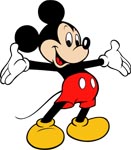Mickey Mouse, the eternal infant, turns 80
 Los Angeles - He was born from misfortune, formed in a creative flash by Walt Disney who had just been dispossessed of his previous cartoon character, Oswald the Lucky Rabbit, in a trademark dispute.
Los Angeles - He was born from misfortune, formed in a creative flash by Walt Disney who had just been dispossessed of his previous cartoon character, Oswald the Lucky Rabbit, in a trademark dispute.
As the cartoon genius sought a replacement, he considered a horse, dog, cat, frog and cow. But his mind kept returning to the mouse he had kept as a pet growing up on the family farm.
Disney's spark of insight was to create an anthropomorphic creature imbued with the roguish yet naive charm of Charlie Chaplin. Disney was smart enough to listen to his wife, who disliked his notion to name the character Mortimer Mouse.
"We felt that the public, and especially the children, like animals that are cute and little. I think we are rather indebted to Charlie Chaplin for the idea," Disney once said.
"We wanted something appealing, and we thought of a tiny bit of a mouse that would have something of the wistfulness of Chaplin - a little fellow trying to do the best he could. When people laugh at Mickey Mouse, it's because he's so human; and that is the secret of his popularity."
Mickey was an instant hit from his very first movie: Steamboat Willie, released on November 18, 1928, as the first cartoon to feature an integrated sound track. The historic debut sees Mickey serving aboard a steamboat under evil Captain Pete, who reduces him to peeling potatoes when Mickey's musical offerings get on his nerves.
In his early movies, Mickey was subtly yet importantly different from the character that became, and remains, one of the best known images in the world. He takes liberties with a cow's udders in Steamboat Willie, and in another movie, Plane Crazy, Mickey lusts so hungrily after Minnie Mouse that she is forced to jump from a plane when he insists on kissing her.
Disney claimed that such behaviour was cut out after fans wrote in to complain. But many cultural critics argue that Mickey was emptied of personality to make him the perfect corporate symbol for Disney's burgeoning family entertainment empire.
Mickey was changing shape, too, in what evolutionary biologist Stephen Jay Gould has claimed was the key factor in cementing his place in hearts around the world. Gould tracked how over the early years, the proportions of his head changed, his limbs became thicker and shorter, and his eyes grew bigger in the face. The effect was to create a character that was a subtle variant of a human baby - the one image that humans are wired by evolution to love above all else.
Whatever the reason, Mickey became one of the most popular characters in the world, a symbol not only of the globe-spanning "Mouse House" but even of US cultural dominance itself. He became a superstar in the Depression years, and over the next two decades Mickey appeared in dozens of short movies before pioneering the merchandising and branding that is now such an important part of the entertainment business.
It started in 1930, when Disney licensed the image to a maker of school supplies for 300 dollars. Since then, Disney has made billions stamping the likeness of the little mouse on everything from computers to underwear to video games. Along the way, he became the only cartoon character with a star on Hollywood's Walk of Fame.
Mickey's enduring stardom is all the more surprising because his last major film role was in 1952. But he has endured thanks to Disney's cable TV channels around the world, and due to his role as the corporate symbol of the conglomerate.
Despite his advanced years, Mickey has no plans to retire.
"For us he is a timeless asset," said a Disney spokesman. "He has the same relevance today as he had on his first day." (dpa)